Greyhound
The Greyhound is a breed of dog, a sighthound which has been bred for coursing game and greyhound racing. It is also referred to as an English Greyhound. Since the rise in large-scale adoption of retired racing Greyhounds, the breed has seen a resurgence in popularity as a family pet.
| Greyhound | |||||||||||||||||||||||||
|---|---|---|---|---|---|---|---|---|---|---|---|---|---|---|---|---|---|---|---|---|---|---|---|---|---|
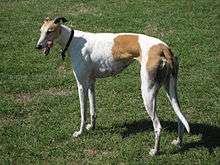 | |||||||||||||||||||||||||
| Other names | English Greyhound | ||||||||||||||||||||||||
| Origin | Great Britain | ||||||||||||||||||||||||
| |||||||||||||||||||||||||
| |||||||||||||||||||||||||
| Dog (domestic dog) | |||||||||||||||||||||||||
According to Merriam-Webster, a Greyhound is "any of a breed of tall slender graceful smooth-coated dogs characterized by swiftness and keen sight", as well as "any of several related dogs", such as the Italian Greyhound.[2][3]
It is a gentle and intelligent breed whose combination of long, powerful legs, deep chest, flexible spine and slim build allows it to reach average race speeds exceeding 64 kilometres per hour (40 mph).[4][5][6] The Greyhound can reach a full speed of 70 kilometres per hour (43 mph) within 30 metres (98 ft), or six strides from the boxes, traveling at almost 20 metres per second (66 ft/s) for the first 250 metres (820 ft) of a race.[7][8]
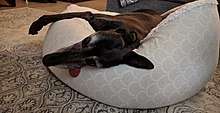
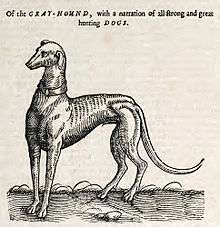
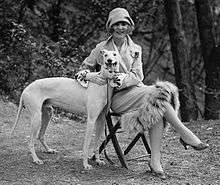
.jpg)
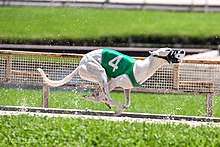
Appearance
Males are usually 71 to 76 centimetres (28 to 30 in) tall at the withers, and weigh on average 27 to 40 kilograms (60 to 88 lb). Females tend to be smaller, with shoulder heights ranging from 66 to 71 centimetres (26 to 28 in) and weights from 25 to 34 kilograms (55 to 75 lb), although weights can be above and below these average weights.[1] Greyhounds have very short fur, which is easy to maintain. There are approximately thirty recognized color forms, of which variations of white, brindle, fawn, black, red and blue (gray) can appear uniquely or in combination.[9] Greyhounds are dolichocephalic, with a skull which is relatively long in comparison to its breadth, and an elongated muzzle.
Temperament
Greyhounds can be aloof and indifferent to strangers, but are affectionate with those they come to know. They are generally very docile, lazy, easy-going, and calm.
Greyhounds wear muzzles during racing, which can lead some to believe they are aggressive dogs, but this is not true. Muzzles are worn to prevent injuries resulting from dogs nipping one another during or immediately after a race, when the 'hare' has disappeared out of sight and the dogs are no longer racing but remain excited.
Contrary to popular belief, adult Greyhounds do not need extended periods of daily exercise, as they are bred for sprinting rather than endurance. Greyhound puppies that have not been taught how to utilize their energy, however, can be hyperactive and destructive if not given an outlet, and therefore require more experienced handlers.[10]
Pets
Greyhound owners consider Greyhounds wonderful pets.[11] They are very loving, and enjoy the company of their humans and other dogs. Whether a Greyhound will enjoy the company of other small animals, such as cats, depends on the individual dog's personality. Greyhounds will typically chase small animals; those lacking a high 'prey drive' will be able to coexist happily with toy dog breeds and/or cats. Many owners describe their Greyhounds as "45-mile-per-hour couch potatoes".[12]
Greyhounds live most happily as pets in quiet environments.[13] They do well in families with children, as long as the children are taught to treat the dog properly with politeness and appropriate respect.[14] Greyhounds have a sensitive nature, and gentle commands work best as training methods.[15]
Occasionally, a Greyhound may bark; however, Greyhounds are generally not barkers, which is beneficial in suburban environments, and are usually as friendly to strangers as they are with their own families.[16]
A very common misconception regarding Greyhounds is that they are hyperactive. This is usually not the case with retired racing Greyhounds.[17] Greyhounds can live comfortably as apartment dogs, as they do not require much space and sleep almost 18 hours per day. Due to their calm temperament, Greyhounds can make better "apartment dogs" than smaller, more active breeds.
Many Greyhound adoption groups recommend that owners keep their Greyhounds on a leash whenever outdoors, except in fully enclosed areas.[18][19][20][21][22][23][24][25] This is due to their prey-drive, their speed, and the assertion that Greyhounds have no road sense.[26] In some jurisdictions, it is illegal for Greyhounds to be allowed off-leash[27] even in off-leash dog parks. Due to their size and strength, adoption groups recommend that fences be between 4 and 6 feet tall, to prevent Greyhounds from jumping over them.[18] As per most breeds being rehomed greyhounds that are adopted after racing tend to need time to adjust to their new lives with a human family. Many guides and books have been published to aid Greyhound owners in helping their pet get comfortable in their new home.[28]
Abilities
Coursing
The original primary use of Greyhounds, both in the British Isles and on the Continent of Europe, was in the coursing of deer for meat and sport; later, specifically in Britain, they specialized in competition hare coursing.[29] Some Greyhounds are still used for coursing, although artificial lure sports like lure coursing and racing are far more common and popular. Many leading 300- to 550-yard sprinters have bloodlines traceable back through Irish sires, within a few generations of racers that won events such as the Irish Coursing Derby or the Irish Cup.[30][31]
Racing
Until the early twentieth century, Greyhounds were principally bred and trained for hunting and coursing. During the 1920s, modern greyhound racing was introduced into the United States, England (1926), Northern Ireland (1927), Scotland (1927) and the Republic of Ireland (1927).[32] Australia also has a significant racing culture.[33][34][35]
In the United States, aside from professional racing, many Greyhounds enjoy success on the amateur race track. Organizations like the Large Gazehound Racing Association (LGRA) and the National Oval Track Racing Association (NOTRA) provide opportunities for Greyhounds to compete.[36][37]
Companion
Historically, the Greyhound has, since its first appearance as a hunting type and breed, enjoyed a specific degree of fame and definition in Western literature, heraldry and art as the most elegant or noble companion and hunter of the canine world. In modern times, the professional racing industry, with its large numbers of track-bred greyhounds, as well as international adoption programs aimed at re-homing dogs has redefined the breed as a sporting dog that will supply friendly companionship in its retirement. This has been prevalent in recent years due to track closures in the United States.[38][39][40] Outside the racing industry and coursing community, the Kennel Clubs' registered breed still enjoys a modest following as a show dog and pet.
Health and physiology
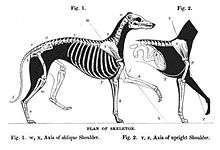
Greyhounds are typically a healthy and long-lived breed, and hereditary illness is rare. Some Greyhounds have been known to develop esophageal achalasia, gastric dilatation volvulus (also known as bloat), and osteosarcoma. If exposed to E. coli, they may develop Alabama rot. Because the Greyhound's lean physique makes it ill-suited to sleeping on hard surfaces, owners of both racing and companion Greyhounds generally provide soft bedding; without bedding, Greyhounds are prone to develop painful skin sores. The average lifespan of a Greyhound is 10 to 14 years.[41][42]
Due to the Greyhound's unique physiology and anatomy, a veterinarian who understands the issues relevant to the breed is generally needed when the dogs need treatment, particularly when anesthesia is required. Greyhounds cannot metabolize barbiturate-based anesthesia in the same way that other breeds can because their livers have lower amounts of oxidative enzymes.[43] Greyhounds demonstrate unusual blood chemistry , which can be misread by veterinarians not familiar with the breed and can result in an incorrect diagnosis.[44]
Greyhounds are very sensitive to insecticides.[45] Many vets do not recommend the use of flea collars or flea spray on Greyhounds if the product is pyrethrin-based. Products like Advantage, Frontline, Lufenuron, and Amitraz are safe for use on Greyhounds, however, and are very effective in controlling fleas and ticks.[46]
Greyhounds have higher levels of red blood cells than other breeds. Since red blood cells carry oxygen to the muscles, this higher level allows the hound to move larger quantities of oxygen faster from the lungs to the muscles.[47] Conversely, Greyhounds have lower levels of platelets than other breeds.[48] Veterinary blood services often use Greyhounds as universal blood donors.[49]
Greyhounds do not have undercoats and thus are less likely to trigger dog allergies in humans (they are sometimes incorrectly referred to as "hypoallergenic"). The lack of an undercoat, coupled with a general lack of body fat, also makes Greyhounds more susceptible to extreme temperatures (both hot and cold); because of this, they must be housed inside.[50] Some greyhounds are susceptible to corns on their paw pads, a variety of methods are used to treat them.[51]
The key to the speed of a Greyhound can be found in its light but muscular build, large heart, highest percentage of fast twitch muscle of any breed,[52][53] double suspension gallop, and extreme flexibility of its spine. "Double suspension rotary gallop" describes the fastest running gait of the Greyhound in which all four feet are free from the ground in two phases, contracted and extended, during each full stride.[54]
History
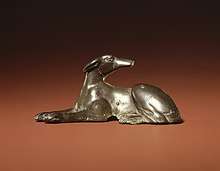
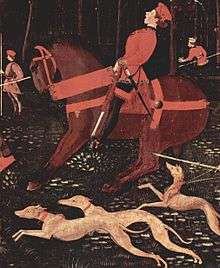
Origins
The ancient skeletal remains of a dog identified as being of the greyhound/saluki form was excavated at Tell Brak in modern Syria, and dated to approximately 4,000 years before present.[55][56]
While similar in appearance to Saluki or Sloughi, DNA sequencing indicates that the greyhound is more closely related to herding dogs.[57][58] This suggests that Greyhounds are either progenitors to or descendants of herding types.[58] Historical literature by Arrian on the vertragus (from the Latin vertragus, a word of Celtic origin),[59] the first recorded sighthound in Europe and possible antecedent of the Greyhound, suggested that its origin lies with the Celts from Eastern Europe or Eurasia. Systematic archaeozoology of the British Isles, 1974 [60] ruled out the existence of a true greyhound-type in Britain prior to the Roman occupation, confirmed in 2000.[61] Written evidence of the historic time, the Vindolanda tablets (No 594), from the early period of Roman occupation demonstrates that the occupying troops from Continental Europe either had with them in the North of England, or certainly knew of the vertragus and its hunting use.[62]
All modern pedigree Greyhounds derive from the Greyhound stock recorded and registered first in private studbooks in the 18th century, then in public studbooks in the 19th century, which ultimately were registered with coursing, racing, and kennel club authorities of the United Kingdom.[63] Historically, these sighthounds were used primarily for hunting in the open where their pursuit speed and keen eyesight were essential.
Etymology
The name "Greyhound" is generally believed to come from the Old English grighund. "Hund" is the antecedent of the modern "hound", but the meaning of "grig" is undetermined, other than in reference to dogs in Old English and Old Norse. Its origin does not appear to have any common root with the modern word "grey"[64] for color, and indeed the Greyhound is seen with a wide variety of coat colors. The lighter colors, patch-like markings and white appeared in the breed that was once ordinarily grey in color. The Greyhound is the only dog mentioned by name in the Bible; many versions, including the King James version, name the Greyhound as one of the "four things stately" in the Proverbs.[65] However, some newer biblical translations, including The New International Version, have changed this to strutting rooster, which appears to be an alternative translation of the Hebrew term mothen zarzir. However, the Douay–Rheims Bible translation from the late 4th-century Latin Vulgate into English translates this term as "a cock."
According to Pokorny[66] the English name "Greyhound" does not mean "grey dog/hound", but simply "fair dog". Subsequent words have been derived from the Proto-Indo-European root *g'her- "shine, twinkle": English grey, Old High German gris "grey, old," Old Icelandic griss "piglet, pig," Old Icelandic gryja "to dawn," gryjandi "morning twilight," Old Irish grian "sun," Old Church Slavonic zorja "morning twilight, brightness." The common sense of these words is "to shine; bright."
In 1928, the first winner of Best in Show at Crufts was breeder/owner Mr. H. Whitley's Greyhound Primley Sceptre.(No.584, pp19 & 121)
A group of greyhounds is called a "leash," or sometimes a "brace."[67]
See also
- Afghan Hound
- Azawakh
- Borzoi (formerly known as Russian Wolfhound)
- Combai
- Chippiparai
- Fastest animal
- Galgo Español (Spanish Greyhound)
- Hortaya borzaya (Russian shorthaired sighthound)
- Irish Wolfhound
- Italian Greyhound
- Kanni
- Longdog (cross between two sighthound breeds)
- Lurcher (sighthound ancestry)
- Magyar agár (Hungarian Greyhound)
- Mudhol Hound
- Polish Greyhound
- Rajapalayam (India)
- Rampur Greyhound
- Saluki
- Scottish Deerhound
- Sloughi
- Whippet
References
- "2018 Oaks first round results". Greyhound Board of Great Britain.
- "Definition of GREYHOUND".
- "Greyhound Dog Breed Information, Pictures, Characteristics & Facts". Dogtime. Retrieved 2020-06-18.
- Gunnar von Boehn. "Shepparton (VIC) Track Records". Greyhound-data.com. Retrieved 2011-05-31.
- Gunnar von Boehn. "Singleton (NSW) Track Records". Greyhound-data.com. Retrieved 2011-05-31.
- Gunnar von Boehn. "Capalaba (QLD) Track Records". Greyhound-data.com. Retrieved 2011-05-31.
- Kohnke, John. BVSc RDA. "GREYHOUND ATHLETE". Greyhound Racing Betting. Retrieved 2012-01-06.
- Sharp, N.C. Craig.Animal athletes: a performance review Veterinary Record Vol 171 (4) 87-94 2012
- "American Kennel Club – Breed Colors and Markings". Akc.org. Retrieved 2011-05-31.
- "Greyhound Rescue and Greyhound Adoption in South Florida FAQ". Friends of Greyhounds. Accessed Nov 5, 2014
- "Breed Standard – Greyhound – Hound". NZKC. Retrieved 2011-05-31.
- "Chuckster's Greyhounds".
- Livinggood, Lee (2000). Retired Racing Greyhounds for Dummies, p. 31. IDG Books Worldwide, Inc., Foster City, CA. ISBN 0-7645-5276-7
- Livinggood 2000, p. 55-56
- Livinggood, Lee (2000). Retired Racing Greyhounds for Dummies. IDG Books Worldwide, Inc., Foster City, CA. ISBN 0-7645-5276-7
- Branigan, Cynthia A. (1998). Adopting the Racing Greyhound, p. 17-18. Howell Book House, New York. ISBN 0-87605-193-X.
- "The Greyhound Adoption Program (GAP) in Australia and New Zealand: A survey of owners' experiences with their greyhounds one month after adoption" Applied Animal Behaviour Science Elliott, 2010 vol:124 iss:3-4 pg:121 -135.
- "Greyhound Adoption League of Texas, Inc. - About the Athletes". Greyhoundadoptiontx.org. Archived from the original on 27 January 2007. Retrieved 2011-05-31.
- "SEGA_Foster_Manual_V7_FINAL_JUne_2006.doc" (PDF). Retrieved 2011-05-31.
- "FAQ". Psgreyhounds.org. Retrieved 2011-05-31.
- "Greyhound Adoption Program – Is a Greyhound Right for You? Archived 2008-01-21 at the Wayback Machine"
- How Safe is an Off-Lead Run?, Adopt a Greyhound
- Peanut. "View topic – Leash Rules". CompassionforGreyhounds.org. Archived from the original on 2011-07-25. Retrieved 2011-05-31.
- "Greyhound Angels Adoption". Greyhound Angels Adoption. Archived from the original on 2011-05-15. Retrieved 2011-05-31.
- "StartLogic".
- "GRV Clubs – GAP". Gap.grv.org.au. Archived from the original on 2011-04-26. Retrieved 2011-05-31.
- "DOMESTIC ANIMALS ACT 1994 – SECT 27 Restraint of greyhounds". www.austlii.edu.au. Retrieved 2015-12-13.
- "Greyt Books on Greyhounds and Greyhound Adoption |". Retrieved 2019-10-17.
- Turberville, George (7 October 2018). "Turbervile's Booke of hunting, 1576". [Oxford] : Clarendon Press ; New York : [Oxford University Press] – via Internet Archive.
- Irish Greyhound Stud Book
- Gunnar von Boehn. "The Greyhound Breeding and Racing Database". Greyhound-data.com. Retrieved 2011-05-31.
- Genders, Roy (1990). NGRC book of Greyhound Racing. Pelham Books Ltd. ISBN 0-7207-1804-X.
- "Greyhound racing". Animals Australia. Retrieved 3 September 2016.
- "Tribute to Chief Havoc -- Australian Greyhound Racing Association".
- "GREY2K USA: Greyhound Racing in Australia".
- "Large Gazehound Racing Association". Lgra.org. Retrieved 2011-05-31.
- "National Oval Track Racing Association". Notra.org. Retrieved 2011-05-31.
- Flaim, Denise (2010) 'Forward Thinking', Sighthound Review, Vol 1 Issue 1.
- "As Dog Racetracks Close, Where Do All the Greyhounds Go?". BlogHer. Retrieved 2011-05-31.
- Madden, Raymond (2010) 'Imagining the greyhound: 'Racing' and 'rescue' narratives in a human and dog relationship', Continuum, 24: 4, 503 — 515 .
- "Summary results of the Purebred Dog Health Survey for Greyhounds" (PDF). The Kennel Club. Kennel Club/British Small Animal Veterinary Association Scientific Committee. Retrieved 6 June 2014.
n=69, median 9 years 1 month
- O’Neill, D. G.; Church, D. B.; McGreevy, P. D.; Thomson, P. C.; Brodbelt, D. C. (2013). "Longevity and mortality of owned dogs in England" (PDF). The Veterinary Journal. 198 (3): 638–43. doi:10.1016/j.tvjl.2013.09.020. PMID 24206631. "n=88 median=10.8 IQR=8.1-12.0"
- Blythe, Linda, Gannon, James, Craig, A. Morrie, and Fegan, Desmond P. (2007). Care of the Racing and Retired Greyhound, p. 416. American Greyhound Council, Inc., Kansas. ISBN 0-9641456-3-4.
- Veterinary Consultants Are Sighthounds Really Dogs?, 2017
- Branigan, Cynthia A. (1998). Adopting the Racing Greyhound, p. 99-101. Howell Book House, New York. ISBN 0-87605-193-X.
- Branigan, Cynthia A. (1998). Adopting the Racing Greyhound, p. 101-103. Howell Book House, New York. ISBN 0-87605-193-X.
- Blythe, Linda, Gannon, James, Craig, A. Morrie, and Fegan, Desmond P. (2007). Care of the Racing and Retired Greyhound, p. 82. American Greyhound Council, Inc., Kansas. ISBN 0-9641456-3-4.
- "Making Sense of Blood Work in Greyhounds" (PDF). Archived from the original (PDF) on 25 March 2009. Retrieved 5 Nov 2014.
- United Blood Services Archived 2006-01-01 at the Wayback Machine article about Greyhounds as blood donors.
- Blythe, Linda, Gannon, James, Craig, A. Morrie, and Fegan, Desmond P. (2007). Care of the Racing and Retired Greyhound, p. 394. American Greyhound Council, Kansas. ISBN 0-9641456-3-4.
- "Greyhound Health. Corns in Greyhounds". www.ngap.org. Retrieved 2019-05-09.
- Snow, D.H. and Harris R.C. "Thoroughbreds and Greyhounds: Biochemical Adaptations in Creatures of Nature and of Man" Circulation, Respiration, and Metabolism Berlin: Springer Verlag 1985
- Snow, D.H. "The horse and dog, elite athletes – why and how?" Proceedings of the Nutrition Society 44 267 1985
- Curtis M Brown. Dog Locomotion and Gait Analysis. Wheat Ridge, Colorado: Hoflin 1986 ISBN 0-86667-061-0
- Clutton-Brock, J., 1989. A dog and a donkey excavated at Tell Brak. Iraq, 51, pp.217-224.
- Structured Deposition of Animal Remains in the Fertile Crescent during the Bronze Age, José Luis Ramos Soldado, Archaeopress, 2016, p12, ISBN 9781784912697
- Mark Derr (May 21, 2004). "Collie or Pug? Study Finds the Genetic Code". The New York Times.
- Parker; et al. (May 2004). "(May 21, 2004). "Genetic Structure of the Purebred Domestic Dog"". Science. 304 (5674): 1160–1164. doi:10.1126/science.1097406. PMID 15155949.
- Arrian; Dansey, W. (1831). Arrian on coursing : the Cynegeticus of the younger Xenophon, translated from the Greek, with classical and practical annotations, and a brief sketch of the life and writings of the author. To which is added an appendix, containing some account of the Canes venatici of classical antiquity. Bohne. pp. 74.
- Harcourt, R.A., 1974. The dog in prehistoric and early historic Britain. Journal of Archaeological Science, 1(2), pp.151-175.
- Clark, K.M., 2000. Dogged persistence: the phenomenon of canine skeletal uniformity in British prehistory. BAR International Series, 889, pp.163-170.
- Bowman, Alan K; Thomas, J David (2003). The Vindolanda writing-tablets (Tabulae Vindolandenses III). British Museum Press. ISBN 978-0-7141-2249-6.
- The Greyhound and the Hare: A history of the breed and the sport Charles Blanning, The National Coursing Club, 2018
- Richardson, Charles (1839). A New Dictionary of the English Language. Oxford University. p. 357.
- Proverbs 30:29–31 King James version.
- Pokorny, Indogermanisches Woerterbuch, pp. 441–442.
- Lipton, James (1991). An Exaltation of Larks. Viking. ISBN 978-0-670-30044-0.
Further reading
- "The Greyhound in 1864: ..." Walsh 1864
- "The Greyhound, ..." Dalziel 1887
- Of Greyhounds and of Their Nature, Chapter XV: "The Master of Game" Edward of York circa 1406
- "The Greyhound" Roger D. Williams, in The American Book of the Dog Editor George O. Shields. Chicago: Rand Mcnally 1891
- Greyhound Nation: A Coevolutionary History of England, 1200-1900 Edmund Russell, Cambridge University Press 2018. ISBN 978-0521762090
- The Greyhound and the Hare: A history of the breed and the sport Charles Blanning, The National Coursing Club, 2018
External links
